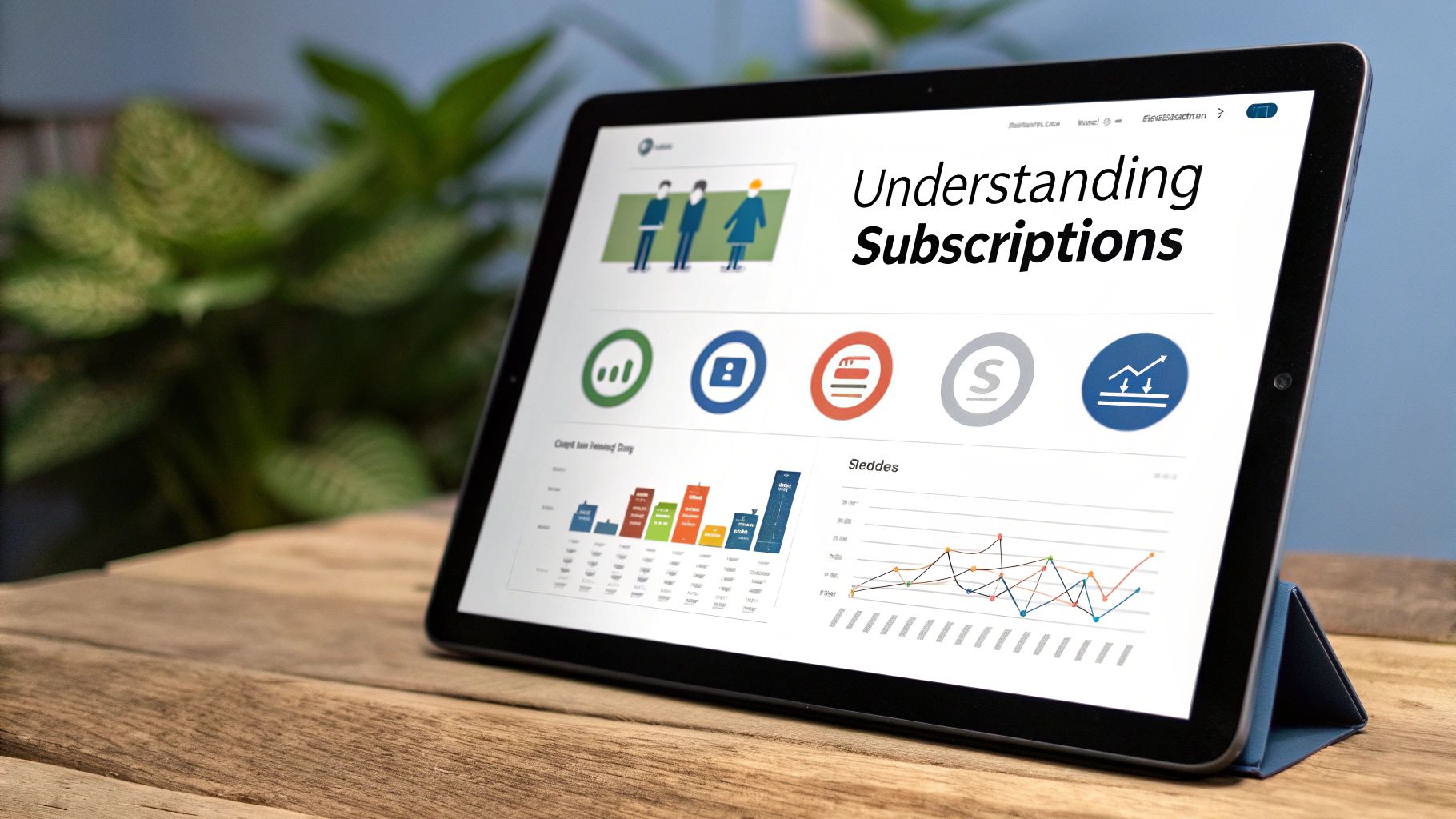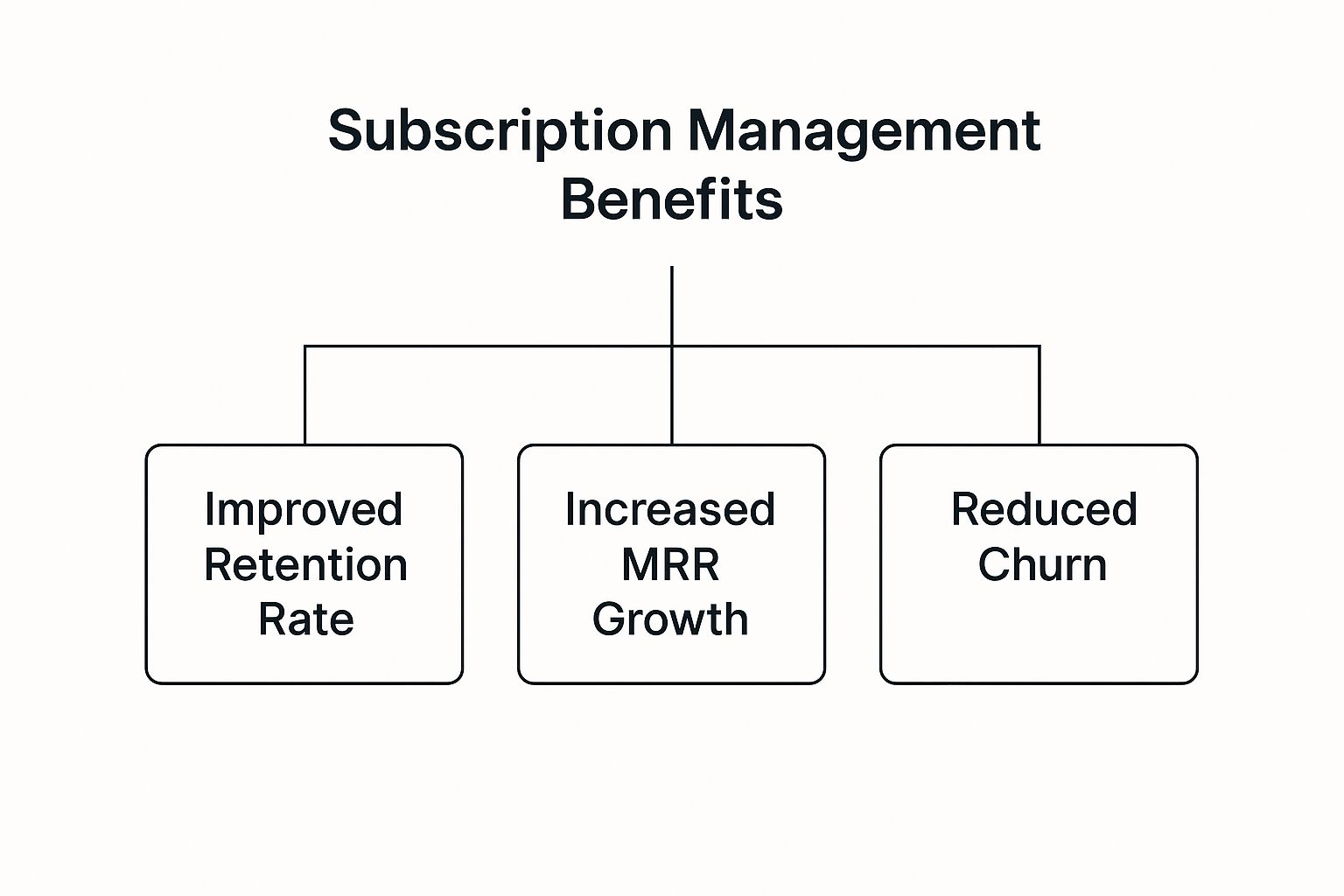
Subscription Management Mastery: Your Complete Growth Guide
Share
Why Subscription Management Is Your Business's Secret Weapon

This screenshot from Wikipedia gives us a snapshot of the subscription business model. Notice how it highlights key parts like getting new customers, billing them regularly, and managing those who cancel. These pieces all work together, and understanding them is important because effective subscription management is what drives predictable revenue. It takes those unpredictable income bursts and turns them into a reliable, recurring stream – like a steady heartbeat for your business. This, in turn, makes financial forecasting and planning much more manageable.
Think of your local gym. It's not just about collecting those monthly dues, right? It's about fostering a sense of community, giving members real value through classes and equipment, and making sure they feel supported on their fitness journey. That's where subscription management fits in. Behind the scenes, it’s orchestrating every interaction, from the moment someone signs up to when they renew, to create a positive customer experience. Businesses are now realizing that the focus needs to be on building long-term relationships, not just closing individual sales.
The Power of Predictable Revenue
Imagine two businesses. One relies on one-off sales, constantly hustling for the next deal, riding the rollercoaster of unpredictable revenue. The other has a thriving subscription model, enjoying the stability of recurring income. Which one do you think can invest in growth and innovation with more confidence? That predictability is one of the biggest perks of mastering subscription management. It creates a much healthier financial environment.
Plus, the focus shifts. Instead of always chasing new customers, the business can concentrate on nurturing the ones they already have. This naturally leads to a higher customer lifetime value, a crucial metric for any subscription business. By reducing churn (people canceling) and increasing the average revenue per user, companies can seriously impact their bottom line. Effective subscription management is the key to unlocking this potential. And that has a ripple effect, even influencing the company's overall valuation.
The Rise of the Subscription Economy
This move toward subscription models isn’t just a fad. The global subscription and billing management market is exploding. In 2024, it was valued at USD 7.90 billion. By 2033, it’s projected to hit USD 20.75 billion, growing at a CAGR of 11.33%. Discover more insights on the subscription market growth here. This shows us a clear trend: people are subscribing to more and more services, and businesses need better tools to manage it all. Just having subscriptions isn’t enough; managing them efficiently is where the real power lies.
This rapid growth underscores the importance of subscription management as a core business function. It’s gone from a “nice-to-have” to a “must-have” for any company that wants to not just survive, but thrive. Next, we'll explore the key ingredients of a successful subscription management system.
The Essential Building Blocks Every Subscription Business Needs
Think of your subscription business as a house. You need solid foundations, reliable plumbing, and a weathertight roof. Likewise, effective subscription management hinges on essential components working in harmony. These core elements are what set thriving subscription businesses apart from those struggling to stay afloat.
The Core Components of Effective Subscription Management
-
Automated Billing: This is your bedrock. Just like a well-oiled machine, automated billing guarantees timely and accurate invoices, minimizing manual errors and freeing up your team's valuable time. It's the dependable plumbing of your subscription business, ensuring everything flows smoothly.
-
Flexible Payment Processing: Imagine offering several entrances to your house, making it easy for guests to enter. Similarly, providing various payment options – from credit cards and PayPal to mobile wallets – is vital for reducing friction at checkout. This flexibility boosts conversions and keeps customers happy.
-
Seamless Customer Communication: Think of clear communication as the electrical wiring of your subscription house. Keeping customers informed about their subscriptions, upcoming renewals, and any important changes fosters trust and reduces churn.
-
Robust Analytics and Reporting: Data is the blueprint of your subscription business, guiding informed decisions. Comprehensive analytics provide crucial insights into customer behavior, empowering you to optimize pricing, improve retention, and spot growth opportunities.
-
Secure Account Management: Just as a strong security system protects your house, robust security measures protect your customers’ valuable data. This builds trust and ensures you comply with regulations.
To illustrate the tangible benefits of effective subscription management, let's look at the infographic below:

As the infographic shows, successful subscription management directly correlates with improved retention rates, increased Monthly Recurring Revenue (MRR) growth, and reduced churn – the cornerstones of a profitable and sustainable subscription business.
To further clarify these crucial components, let’s examine a comparison table highlighting their functions and impact.
To help visualize these vital elements, we’ve compiled a comparison table.
Essential Subscription Management Components Comparison A detailed comparison of core subscription management features and their business impact
| Component | Primary Function | Business Impact | Implementation Priority |
|---|---|---|---|
| Automated Billing | Automates invoice generation and payment collection | Reduces manual errors, improves efficiency, and minimizes late payments | High |
| Flexible Payment Processing | Supports multiple payment methods and currencies | Increases conversion rates, improves customer satisfaction, and expands market reach | High |
| Seamless Customer Communication | Facilitates proactive and personalized communication throughout the customer lifecycle | Builds trust, reduces churn, and improves customer lifetime value | High |
| Robust Analytics and Reporting | Tracks key subscription metrics and provides actionable insights | Enables data-driven decision-making, optimizes pricing and packaging, and identifies growth opportunities | Medium |
| Secure Account Management | Protects customer data and ensures compliance with regulations | Builds trust, minimizes security risks, and enhances brand reputation | High |
This table emphasizes the interconnectedness of each component and how they contribute to a thriving subscription business. Prioritizing these elements is crucial for long-term success.
Scaling Your Subscription Management as You Grow
As your subscriber base expands, so too must your subscription management system. What works for a small startup won’t necessarily work for a larger company. This means investing in scalable solutions designed to handle increasing complexity. To explore various options for your business, check out our guide on top subscription management tools: Top Subscription Management Tools for Your Business. Building a robust subscription management system is like laying a strong foundation for your house – it ensures long-term stability and supports future growth. Selecting the right tools early on will save you headaches down the line and let you focus on what truly matters: scaling your business.
The New Reality Of Customer Acquisition That Changes Everything

The subscription world has changed. Remember the old days of attracting customers with big, expensive ad campaigns and generic marketing emails? Those tactics are becoming less effective. Imagine fishing with dynamite. Sure, you might catch something, but you're also disrupting the entire ecosystem. Similarly, outdated acquisition tactics often attract the wrong subscribers – the ones who leave quickly and don't offer much long-term value.
This isn't just a hunch; it's reflected in the data. Subscription businesses saw acquisition rates fall from 4.1% in 2021 to 2.8% in 2024. This tells us getting new subscribers is getting harder and more expensive. But there's good news: return acquisitions now represent 20% of new subscribers. This underscores the power of building relationships, even with people who have canceled their subscriptions in the past. Explore the evolving trends in subscription acquisition here.
Focusing on Quality Over Quantity
Successful businesses understand that true growth in the subscription economy hinges on attracting the right customers and nurturing those relationships. Think of it like tending a garden. You carefully nurture each plant (customer) to ensure it thrives and produces fruit (long-term value). It's a world away from indiscriminately dousing a field with fertilizer.
This approach prioritizes quality over quantity. Instead of chasing superficial metrics like follower counts, smart subscription companies focus on engagement and customer satisfaction. They recognize that a small group of loyal subscribers is far more valuable than a large group of disengaged ones.
Turning Churned Customers Into Loyal Advocates
Here’s a surprising idea: your former customers might be your greatest untapped resource. Why? Because they can tell you exactly what went wrong and what you can do better. Think of them as valuable sources of feedback, not lost causes. Understanding why they canceled is key to addressing underlying issues and reducing future churn.
Even better, you can often win these customers back. A thoughtful re-engagement strategy, maybe with a special offer or by directly addressing their previous concerns, can transform former subscribers into loyal advocates. As the data shows, these "return acquisitions" are becoming increasingly important.
Practical Approaches for Improved Acquisition
So, what actually works in this new landscape? Building genuine relationships with potential and existing subscribers. This involves:
- Personalized communication: Tailor your message to resonate with each customer's unique needs and preferences.
- Exceptional customer service: Provide prompt, helpful support that goes beyond simple transactions.
- Building community: Foster a sense of belonging among your subscribers to build loyalty and encourage word-of-mouth referrals.
- Value-driven content: Offer useful resources and information to showcase your expertise and build trust.
These strategies focus on creating long-term value, not just quick wins. By investing in these areas, you're building a sustainable subscription business that attracts the right customers and keeps them engaged over time. This is where subscription management comes in. By streamlining the entire subscriber journey, you can create a seamless experience that cultivates loyalty and maximizes customer lifetime value.
Riding The Subscription Economy Wave Before It Peaks
The way we buy things is changing. Think about it – how many services do you pay for monthly without a second thought? This shift to the subscription model is arguably the biggest change in consumer behavior since the introduction of credit cards, and it’s impacting almost every industry. Let's explore this explosive growth and how businesses can capitalize on it.
Understanding The Forces Driving Subscription Growth
What’s fueling this growth? Think about your own subscriptions. Aren’t they just…easier? The convenience of automatic renewals and predictable billing is a huge draw for consumers. Plus, subscriptions often offer personalized experiences, tailoring offerings to individual needs in ways traditional retail can't.
For businesses, subscriptions mean predictable recurring revenue. It’s like having a financial engine humming smoothly in the background. This predictable income allows for better planning and investment. It also fosters deeper customer relationships, building loyalty and providing valuable insights into consumer behavior.
This shift isn’t limited to streaming services anymore. We’re seeing subscription models everywhere – meal kits, clothing, pet food, even car maintenance. This widespread adoption signals a fundamental change in what consumers expect. It’s an exciting time for businesses willing to adapt.
Entering The Subscription Economy: Strategies And Pitfalls
So, how can businesses dive into the subscription world? There are several approaches. Offering a freemium model is one way – provide a basic service for free and charge for premium features. Think Spotify or LinkedIn. Another approach is bundling existing products into subscription packages, adding value through convenience and exclusive content.
But entering the subscription economy isn’t a guaranteed win. One common pitfall is not truly understanding your target audience. Imagine designing a subscription box for gardeners without knowing what kind of plants they like! Thorough market research is essential.
Another critical element is subscription management. This involves everything from billing and payments to customer communication and keeping customers happy. Without a solid system, managing subscriptions can become a nightmare, leading to frustrated customers and lost revenue.
The subscription e-commerce market is exploding. It’s projected to reach USD 20.58 billion in 2025 and a potential USD 46.05 billion by 2034. The overall subscription economy is estimated to reach a staggering $3 trillion in 2025. Discover more insights into these booming statistics. This growth underscores the importance of a well-defined subscription management strategy. Understanding this evolving landscape is the key to thriving in this new market. By understanding what’s driving subscription growth and avoiding common mistakes, businesses can ride this wave to long-term success.
The Proven Strategies That Separate Winners From Wannabes

Think of building a successful subscription business like cultivating a dedicated fan base for your favorite band. One hit song isn't enough; you need consistent quality, engaging experiences, and a real connection with your audience. That’s what subscription management is all about: understanding your customer and giving them what they need.
Optimizing Pricing for Long-Term Value
Pricing your subscription is like walking a tightrope. Too high, and customers jump ship. Too low, and you're leaving money on the table. The key is finding the sweet spot where customers see the value and you make a profit.
One effective strategy is tiered pricing. This gives customers options, letting them choose the plan that fits their budget and needs. This sense of control makes them feel like they're getting a good deal.
Another important factor is the psychology of pricing. Sometimes, a slightly higher price can actually signal higher value, especially when you clearly communicate the benefits and features that justify the cost. This reinforces the importance of building trust and demonstrating value.
Creating Onboarding Experiences That Stick
First impressions are crucial. Your onboarding process is like the opening act at a concert. A great opener gets the crowd excited for the headliner. Similarly, a smooth and engaging onboarding experience helps customers understand your service's value and reduces early cancellations.
Effective onboarding might involve welcome emails, tutorials, or personalized recommendations. The goal is to make it easy for customers to get started and quickly see the benefits. This sets the stage for a long and happy subscription.
Building Retention Programs That Actually Work
Acquiring new customers is great, but keeping your existing ones is just as important. Think of retention programs as providing exclusive behind-the-scenes content to your most loyal fans. It creates a sense of community and makes them feel valued.
These programs could involve loyalty rewards, exclusive content, or personalized support. The key is making subscribers feel appreciated and encouraging them to stick around.
To understand how these best practices can impact your bottom line, take a look at the table below. It provides a quantitative analysis of how each practice can affect your key metrics.
Subscription Management Best Practices Impact Analysis
| Best Practice | Implementation Difficulty | Customer Retention Impact | Revenue Impact | Time to Results |
|---|---|---|---|---|
| Tiered Pricing | Low | Medium | High | Short |
| Personalized Onboarding | Medium | High | High | Medium |
| Loyalty Programs | Medium | High | Medium | Long |
| Proactive Customer Support | High | High | High | Long |
As you can see, while some best practices are easier to implement than others, all of them can contribute to a healthier and more profitable subscription business. Focusing on those with high impact and shorter time to results can offer quick wins, while investing in the more complex practices can build long-term sustainable growth.
Beyond Monthly Recurring Revenue: Building Relationships That Last
While Monthly Recurring Revenue (MRR) is a vital metric, truly successful subscription businesses focus on building lasting customer relationships. This means understanding customer needs, offering excellent support, and constantly improving your service. Think less about transactions, and more about genuine engagement. For example, exploring innovative models like group buying can create shared value and enhance the overall experience. Check out our guide to learn more: You might be interested in: Group Buying for Business – Boost Growth & Save Costs.
By prioritizing customer relationships, you build a loyal following that not only generates revenue but also acts as enthusiastic brand advocates.
Avoiding Common Subscription Management Mistakes
Even with the best strategies, common mistakes can derail your efforts. Ignoring customer feedback, failing to adapt to market changes, or neglecting your subscription management infrastructure can lead to increased cancellations, lower customer lifetime value, and reduced profitability. By being aware of these pitfalls, you can proactively address them and build a more resilient subscription model.
How Group-Buying Is Reshaping Subscription Management
Traditional subscription management can feel like juggling. You’ve got multiple services, different billing cycles, and a growing pile of invoices. Group-buying offers a refreshing alternative. Imagine teaming up with friends to share the cost of that must-have streaming service – that’s the core concept. It’s not just about saving money; it’s about smarter, safer, and simpler management.
AccountShare's website, as seen in this screenshot, provides a clear example of how this works. Notice the clean layout and the range of services offered, everything from entertainment to software. The platform emphasizes transparency and ease of use, making shared subscriptions much less of a headache.
The Power of Shared Accountability and Cost Benefits
Group-buying adds a layer of security through shared accountability. Think of it like a potluck dinner: everyone contributes and everyone benefits from a shared meal. Similarly, in a group-buying scenario, everyone is invested in keeping the account secure. This encourages responsible use and helps prevent unauthorized access.
Cost efficiency is a big win. That premium software or online course that seemed too expensive suddenly becomes attainable when the cost is shared. This opens up opportunities for people to access services they might not have considered before, which is a bonus for both consumers and businesses.
Streamlining Management for Everyone
Group-buying simplifies the administrative burden. Rather than everyone managing their individual subscriptions, one person handles the shared account. It’s like carpooling for your subscriptions! This significantly reduces the hassle of individual billing and renewals, making life easier for everyone involved. For a deeper dive into improving subscription workflows, check out this guide: Revamp Your Subscription Management Workflow.
For businesses, this translates to simpler billing and fewer individual customer interactions. They can focus on improving their core services instead of getting tangled up in individual account management.
Expanding Market Reach and Opportunity
Group-buying helps businesses reach new customer segments. Think of a fitness studio offering a discounted group rate for families. This allows them to connect with people who may not have signed up individually.
This also opens doors for creative pricing strategies. Businesses can test different group sizes and price points, offering tailored options to attract a wider range of customers.
The Future of Subscription Management
Group-buying may be relatively new, but it signals a real change in how we think about subscriptions. It tackles long-standing challenges in traditional subscription management while creating new opportunities. By blending affordability, improved security, and streamlined administration, group-buying is making subscriptions more accessible and user-friendly. As more and more services move to a subscription model, this collaborative approach has the potential to reshape how we access and manage the tools and entertainment we use every day.
Your Roadmap To Subscription Management Success
Imagine planning a cross-country road trip. You wouldn't just hop in the car and start driving, right? You'd map out your route, plan your stops, and pack for unexpected detours. Subscription management is similar. It requires a well-defined roadmap to guide you through each step of the customer lifecycle.
Assessing Your Current Capabilities
Before hitting the open road, you'd check your car's vitals – oil, tire pressure, and the like. Assessing your current subscription management processes is just as important. Ask yourself some key questions: Are your current processes efficient? Do they offer the flexibility your customers expect? Are you collecting the data you need to make smart decisions? This initial assessment will highlight your starting point.
Identifying Gaps and Prioritizing Improvements
Once you understand where you stand, you can identify areas for improvement. Maybe your billing system is clunky and outdated. Perhaps your customer communication feels impersonal. Prioritize these gaps based on their potential business impact. Like fixing a flat tire before buffing out a minor scratch, focus on the improvements that will benefit your subscribers the most.
Key Metrics for Predicting Success
Just as you track mileage and fuel consumption on a road trip, you need to monitor key metrics in your subscription business. Think of these metrics as your GPS: Customer Lifetime Value (CLTV) tells you how much revenue you can expect from a single customer over their entire relationship with your business. Monthly Recurring Revenue (MRR) gives you a snapshot of your predictable monthly income. And your churn rate shows you how many customers are cancelling their subscriptions. These metrics provide valuable insights into your business performance and guide you towards sustainable growth.
Common Pitfalls to Avoid
Even the most carefully planned road trips encounter potholes. Similarly, there are common traps that can sidetrack even the most promising subscription businesses. Failing to keep up with changing customer expectations, ignoring customer feedback, and overlooking security risks can lead to lost revenue and unhappy subscribers. Knowing these pitfalls in advance helps you avoid them and keep your business moving forward.
Strategic Decisions for Sustainable Growth
Long-term success requires strategic planning. Just as you'd book your accommodations in advance for a long road trip, you need to make decisions that set your business up for sustainable growth. This could mean investing in new technology that can scale with your business, crafting personalized customer experiences, or exploring innovative business models like group buying.
Measuring Progress and Adapting to Change
Even with the best map, detours are sometimes necessary. Market conditions change, customer preferences evolve, and new technologies emerge. Regularly check your progress against your goals and be flexible enough to change your approach when needed. Think of it like checking traffic reports on your road trip - staying informed lets you adapt and still reach your destination.
AccountShare offers a powerful solution for simplifying and strengthening your subscription management. By harnessing the power of group buying, AccountShare helps you access premium services at lower prices while streamlining account management and enhancing security. Ready to start your journey toward subscription success? Visit AccountShare to learn more.
